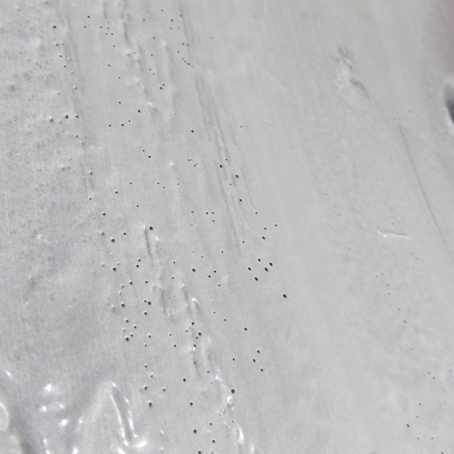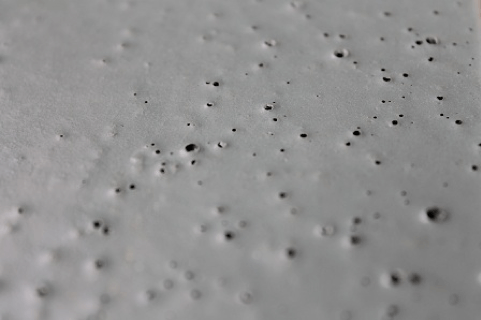Welcome to the Inspector’s Corner Series of DECO Coatings. This series will offer quarterly tips, advice, and insight from an inspector’s perspective. Let’s get nerdy!
Disclaimer: topics and advice are all from the opinion of DECO Coating’s in-house inspector and apart of DECO Coatings best practices. Some topics may not be enforceable by specification, only to act as a guide in assessing coating failures and performing basic tests. Every project is unique, and any inspector or contractor shall always refer to job specification and referenced standards.
HOLIDAY TEST
What is it?
A holiday test is a non-destructive test method applied on conductive substrates to determine the presence and number of discontinuities in a nonconductive coating film.
Two types of test equipment: low-voltage wet sponge and high-voltage spark. Low voltage holiday detectors are only able to detect holes in the coating that go all the way through the coating to the metal substrates. High voltage holiday detectors can detect weaknesses in the coating that do not penetrate to the conductive substrate. Not all coatings may be high voltage tested. Also, not all types of structures or industries use holiday detectors.

Each have their own perimeters. It is important to consult with the coating manufacturer on which type of tester may be used on the specified coating and thickness. As well as what interval (cure), test shall be conducted. We will discuss low-voltage test here.
Why is it important?
Holiday testing is performed to find defects or discontinuities, not readily visible, in coating films such as: pinholes, fisheyes, cratering, and nicks. These defects or discontinuities will cause future coating failure once the substrate is introduced to humidity, moistures or other accelerants that will begin the corrosion process. Correcting these defects are especially important for any type of substrate that will be immersed, like tanks and pipelines.
Pinholes are the majority defect type we come across. Pinholes are holes through a coat or coats that expose the metal substrate. Once the metals substrate is exposed to corrosion accelerants, rusting will begin.


How is it performed?
Low-voltage wet sponge tester is an electronic device powered by a self-contained battery with voltages ranging from 5 to 90V. Operation includes the use of an open-cell sponge electrode saturated with a solution for exploring the coating surface, a ground connection, and an audible or visual indicator for signaling a point of discontinuity.
Important tips:
- Ground cable is attached directly to substrate and tested
- Sponge saturated with a solution of tap water/wetting agent (1oz/gal)
- Move sponge at a maximum rate of (1 linear ft/s) double stroke
- Used on coatings up to 20 mils
- May be used on concrete
- Ensure PPE is observed, and risk of electric shock has been evaluated
- Identify discontinuities (repair areas) with a marker that is compatible with the repair coating or one that is easily removable.
CAUTION: High Voltage testing may cause coating film to crack or damage if less than 20 mils. Always consult with coating manufacturer prior to conducting test.
Laura performing low voltage test in field
Is it possible to receive a false/positive outcome?
There are common errors with performing this test:
Failure to keep the probe in contact with the surface
- Moving the sponge too fast or slow across the surface
- Over or under saturating the sponge
- Low battery or bad lead
- Inadequate ground connection
- Surface is too wet
Referenced Standards?
Always check the coating specification for specified standards to follow. It should also state within coating specification pass/fail criteria. Given variables to each project with coating film thickness, design, and service condition – the acceptable number of discontinuities shall be outlined prior to conducting the test.
NACE SP0188 (www.nace.org): Describes procedures for determining discontinuities using two types of test equipment: low-voltage wet sponge testers and high-voltage spark testers. The standard is intended for use only with new coatings applied to conductive substrates.
Other Standards applicable for electrical inspection to pipelines: RP0274, RP0490,TM0384.
Next Steps?
1. Determine if holiday testing is specified and what criteria has been listed in specification. If none, ask for clarification during coating pre-installation meeting. It is important to get this information out in front prior to any coating installation. Who is responsible for testing and how often?
2. Check with manufacture to ensure specified coating may be testing and at what interval.
3. Take lots of photos and record repairs. Detailed is the advantage here. DECO suggests before/after photos with detailed locations, most companies have their own report form. Important to document climatic activity and mil thickness during repair work too.
Summary:
Holiday testing is a popular quality assurance test within the water/wastewater; pipeline; and tank industries. It shall be the responsibility of the Owner/Engineer to enforce such test, as well as write into specification: responsibilities, pass/fail criteria, and reference standards. Although holiday testing may be performed by the Contractor, it is a best practice for the Owner to hire a third-party inspector to oversee the coating project and testing. Testing should be conducted by NACE Certified Inspectors. Therefore, results cannot be misinterpreted.
DECO Coatings has past performance with holiday testing and developed internal reports and checklist to assist with Owner enforcement. Contact the nerds today!